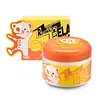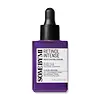What's inside
What's inside
 Key Ingredients
Key Ingredients

 Benefits
Benefits

 Concerns
Concerns

 Ingredients Side-by-side
Ingredients Side-by-side

Swiftlet Nest Extract
Skin ConditioningMacadamia Integrifolia Seed Oil
Skin ConditioningBeeswax
Emulsion StabilisingCetyl Alcohol
EmollientGlycerin
HumectantPolysorbate 60
EmulsifyingDipropylene Glycol
HumectantRetinol
Skin ConditioningSh-Oligopeptide-1
Skin ConditioningSodium Polyacrylate
AbsorbentAllantoin
Skin ConditioningPEG-100 Stearate
Adenosine
Skin ConditioningCarbomer
Emulsion StabilisingBetaine
HumectantPropylene Glycol
HumectantCaprylic/Capric Triglyceride
MaskingPolysorbate 20
EmulsifyingArginine
MaskingAlcohol
Antimicrobial1,2-Hexanediol
Skin ConditioningCeteth-3
EmulsifyingBrassica Campestris Sterols
EmollientTocopheryl Acetate
AntioxidantCetyl Phosphate
EmulsifyingCholesterol
EmollientPEG-5 Rapeseed Sterol
CleansingHydrogenated Lecithin
EmulsifyingEthylhexylglycerin
Skin ConditioningWater
Skin ConditioningSorbitan Sesquioleate
EmulsifyingCeteth-5
EmulsifyingDisodium EDTA
Glyceryl Stearate
EmollientParfum
MaskingSwiftlet Nest Extract, Macadamia Integrifolia Seed Oil, Beeswax, Cetyl Alcohol, Glycerin, Polysorbate 60, Dipropylene Glycol, Retinol, Sh-Oligopeptide-1, Sodium Polyacrylate, Allantoin, PEG-100 Stearate, Adenosine, Carbomer, Betaine, Propylene Glycol, Caprylic/Capric Triglyceride, Polysorbate 20, Arginine, Alcohol, 1,2-Hexanediol, Ceteth-3, Brassica Campestris Sterols, Tocopheryl Acetate, Cetyl Phosphate, Cholesterol, PEG-5 Rapeseed Sterol, Hydrogenated Lecithin, Ethylhexylglycerin, Water, Sorbitan Sesquioleate, Ceteth-5, Disodium EDTA, Glyceryl Stearate, Parfum
Water
Skin ConditioningCyclohexasiloxane
EmollientDicaprylyl Carbonate
EmollientGlycerin
HumectantMethylpropanediol
Solvent1,2-Hexanediol
Skin ConditioningNiacinamide
SmoothingHydrogenated Poly(C6-14 Olefin)
EmollientPanthenol
Skin ConditioningTocopheryl Acetate
AntioxidantPiper Methysticum Leaf/Root/Stem Extract
Skin ConditioningCentella Asiatica Extract
CleansingPanax Ginseng Berry Extract
Skin ConditioningGlycyrrhiza Glabra Root Extract
BleachingFicus Carica Fruit Extract
HumectantCentella Asiatica Leaf Extract
Skin ConditioningCentella Asiatica Root Extract
Skin ConditioningMelaleuca Alternifolia Leaf Extract
PerfumingArtemisia Capillaris Extract
Eclipta Prostrata Extract
Skin ConditioningMelia Azadirachta Leaf Extract
Skin ConditioningElaeis Guineensis Oil
EmollientHydrogenated Lecithin
EmulsifyingGlyceryl Stearate
EmollientBakuchiol
AntimicrobialPalmitic Acid
EmollientSodium Polyacrylate
AbsorbentStearic Acid
CleansingXanthan Gum
EmulsifyingRetinol 0.1%
Skin ConditioningAcrylates/C10-30 Alkyl Acrylate Crosspolymer
Emulsion StabilisingButylene Glycol
HumectantDipotassium Glycyrrhizate
HumectantAdenosine
Skin ConditioningTromethamine
BufferingPolyquaternium-51
Skin ConditioningBeta-Glucan
Skin ConditioningCetyl Alcohol
EmollientBHT
AntioxidantCollagen
MoisturisingMyristic Acid
CleansingBHA
AntioxidantLeuconostoc/Radish Root Ferment Filtrate
AntimicrobialTocopherol
AntioxidantBifida Ferment Lysate
Skin ConditioningCeramide NP
Skin ConditioningSaccharomyces Ferment
Skin ConditioningRetinal
Skin ConditioningAsiaticoside
AntioxidantGlyceryl Polymethacrylate
Madecassoside
AntioxidantPropylene Glycol
HumectantPolyglyceryl-10 Oleate
Skin ConditioningGlycolipids
Skin ConditioningGlycine Soja Peptide
Skin ConditioningResveratrol
AntioxidantSucrose Distearate
EmollientAsiatic Acid
Skin ConditioningMadecassic Acid
Skin ConditioningPalmitoyl Tripeptide-1
Skin ConditioningMoringa Oleifera Seed Oil
EmollientPEG-100 Stearate
Polysorbate 20
EmulsifyingParfum
MaskingEthylhexylglycerin
Skin ConditioningWater, Cyclohexasiloxane, Dicaprylyl Carbonate, Glycerin, Methylpropanediol, 1,2-Hexanediol, Niacinamide, Hydrogenated Poly(C6-14 Olefin), Panthenol, Tocopheryl Acetate, Piper Methysticum Leaf/Root/Stem Extract, Centella Asiatica Extract, Panax Ginseng Berry Extract, Glycyrrhiza Glabra Root Extract, Ficus Carica Fruit Extract, Centella Asiatica Leaf Extract, Centella Asiatica Root Extract, Melaleuca Alternifolia Leaf Extract, Artemisia Capillaris Extract, Eclipta Prostrata Extract, Melia Azadirachta Leaf Extract, Elaeis Guineensis Oil, Hydrogenated Lecithin, Glyceryl Stearate, Bakuchiol, Palmitic Acid, Sodium Polyacrylate, Stearic Acid, Xanthan Gum, Retinol 0.1%, Acrylates/C10-30 Alkyl Acrylate Crosspolymer, Butylene Glycol, Dipotassium Glycyrrhizate, Adenosine, Tromethamine, Polyquaternium-51, Beta-Glucan, Cetyl Alcohol, BHT, Collagen, Myristic Acid, BHA, Leuconostoc/Radish Root Ferment Filtrate, Tocopherol, Bifida Ferment Lysate, Ceramide NP, Saccharomyces Ferment, Retinal, Asiaticoside, Glyceryl Polymethacrylate, Madecassoside, Propylene Glycol, Polyglyceryl-10 Oleate, Glycolipids, Glycine Soja Peptide, Resveratrol, Sucrose Distearate, Asiatic Acid, Madecassic Acid, Palmitoyl Tripeptide-1, Moringa Oleifera Seed Oil, PEG-100 Stearate, Polysorbate 20, Parfum, Ethylhexylglycerin
 Reviews
Reviews

Ingredients Explained
These ingredients are found in both products.
Ingredients higher up in an ingredient list are typically present in a larger amount.
1,2-Hexanediol is a synthetic liquid and another multi-functional powerhouse.
It is a:
- Humectant, drawing moisture into the skin
- Emollient, helping to soften skin
- Solvent, dispersing and stabilizing formulas
- Preservative booster, enhancing the antimicrobial activity of other preservatives
Adenosine is in every living organism. It is one of four components in nucleic acids that helps store our DNA.
Adenosine has many benefits when used. These benefits include hydrating the skin, smoothing skin, and reducing wrinkles. Once applied, adenosine increases collagen production. It also helps with improving firmness and tissue repair.
Studies have found adenosine may also help with wound healing.
In skincare products, Adenosine is usually derived from yeast.
Learn more about AdenosineCetyl Alcohol is a fatty alcohol. Fatty Alcohols are most often used as an emollient or to thicken a product.
Its main roles are:
Though it has "alcohol" in the name, it is not related to denatured alcohol or ethyl alcohol.
The FDA allows products labeled "alcohol-free" to have fatty alcohols.
Learn more about Cetyl AlcoholEthylhexylglycerin (we can't pronounce this either) is commonly used as a preservative and skin softener. It is derived from glyceryl.
You might see Ethylhexylglycerin often paired with other preservatives such as phenoxyethanol. Ethylhexylglycerin has been found to increase the effectiveness of these other preservatives.
Glycerin is already naturally found in your skin. It helps moisturize and protect your skin.
A study from 2016 found glycerin to be more effective as a humectant than AHAs and hyaluronic acid.
As a humectant, it helps the skin stay hydrated by pulling moisture to your skin. The low molecular weight of glycerin allows it to pull moisture into the deeper layers of your skin.
Hydrated skin improves your skin barrier; Your skin barrier helps protect against irritants and bacteria.
Glycerin has also been found to have antimicrobial and antiviral properties. Due to these properties, glycerin is often used in wound and burn treatments.
In cosmetics, glycerin is usually derived from plants such as soybean or palm. However, it can also be sourced from animals, such as tallow or animal fat.
This ingredient is organic, colorless, odorless, and non-toxic.
Glycerin is the name for this ingredient in American English. British English uses Glycerol/Glycerine.
Learn more about GlycerinGlyceryl Stearate is a mix of glycerin and stearic acid.
It is used to stabilize the mixing of water and oil ingredients. By preventing these ingredients from separating, it can help elongate shelf life. It can also help thicken the product's texture.
As an emollient, it helps soften skin and supports barrier-replenishing ingredients.
In cosmetics, Glyceryl Stearate is often made from vegetable oils or synthetically produced.
This ingredient may not be fungal-acne safe
Fun fact: The human body also creates Glyceryl Stearate naturally.
Learn more about Glyceryl StearateHydrogenated Lecithin is created from the hydrogenation of lecithin (a group of phospholipids). Hydrogenation is a chemical reaction between hydrogen and another element.
This ingredient is an emollient and emulsifier. As an emollient, it helps soften skin by trapping moisture within. As an emulsifier, it prevents oil and water ingredients from separating.
Parfum is a catch-all term for an ingredient or more that is used to give a scent to products.
Also called "fragrance", this ingredient can be a blend of hundreds of chemicals or plant oils. This means every product with "fragrance" or "parfum" in the ingredients list is a different mixture.
For instance, Habanolide is a proprietary trade name for a specific aroma chemical. When used as a fragrance ingredient in cosmetics, most aroma chemicals fall under the broad labeling category of “FRAGRANCE” or “PARFUM” according to EU and US regulations.
The term 'parfum' or 'fragrance' is not regulated in many countries. In many cases, it is up to the brand to define this term.
For instance, many brands choose to label themselves as "fragrance-free" because they are not using synthetic fragrances. However, their products may still contain ingredients such as essential oils that are considered a fragrance by INCI standards.
One example is Calendula flower extract. Calendula is an essential oil that still imparts a scent or 'fragrance'.
Depending on the blend, the ingredients in the mixture can cause allergies and sensitivities on the skin. Some ingredients that are known EU allergens include linalool and citronellol.
Parfum can also be used to mask or cover an unpleasant scent.
The bottom line is: not all fragrances/parfum/ingredients are created equally. If you are worried about fragrances, we recommend taking a closer look at an ingredient. And of course, we always recommend speaking with a professional.
Learn more about ParfumPeg-100 Stearate is an emollient and emulsifier. As an emollient, it helps keep skin soft by trapping moisture in. On the other hand, emulsifiers help prevent oil and water from separating in a product.
PEGS are a hydrophilic polyether compound . There are 100 ethylene oxide monomers in Peg-100 Stearate. Peg-100 Stearate is polyethylene glycol ester of stearic acid.
Polysorbate 20 is made by combining ethoxylation of sorbitan, ethylene oxide, and lauric acid. It is a mild cleansing agent, surfactant, and emulsifier.
As a surfactant, it helps collect dirt and oils for washing. Emulsifiers prevent oils and water from separating.
Polysorbate 20 also adds scent to a product. Since it is made using sorbitol, it has a sweet scent. Sorbitol can also be found in fruits such as apples and peaches.
The lauric acid used to create Polysorbate 20 is often derived from coconuts.
Polysorbate 20 may not be fungal acne safe.
Learn more about Polysorbate 20Propylene Glycol is an odorless, colorless liquid. As a humectant, it helps skin retain moisture. It also aids in delivering active ingredients.
Another role of this ingredient is preventing a product from melting or freezing. Propylene glycol also adds antimicrobrial properties to a product, elongating product lifespan.
This ingredient is considered an organic alcohol and commonly added into both cosmetics and foods.
Those with sensitive skin or conditions may develop a rash when using this ingredient.
Learn more about Propylene GlycolRetinol is a gold-standard ingredient for anti-aging. It is a form of Vitamin A and belongs to the class of retinoids that also includes tretinoin.
Why is retinol famous?
It has the most scientific studies backing up its skin benefits out of all the non-prescription ingredients.
Retinol is proven to:
This is why retinol is effective at removing wrinkles, fading dark spots, treating acne, and reducing the appearance of pores.
Studies show retinol is less effective when exposed to UV. Be sure to look for appropriate packaging to keep your retinol potent (similar to Vitamin C).
Using retinol or any retinoids will increase sun-sensitivity in the first few months. Though studies show retinoids increase your skin's natural SPF with continuous use, it is best to always wear sunscreen and sun-protection.
We recommend speaking with a medical professional about using this ingredient during pregnancy.
Retinol may cause irritation in some people, so be sure to patch test. Experts recommend 'ramping up' retinol use: start using this ingredient once a week and work up to using it daily.
Read about Tretinoin
Learn more about RetinolSodium Polyacrylate is the sodium salt of polyacrylic acid. It is used as an absorber, emollient, and stabilizer.
This ingredient is a super-absorbent polymer - meaning it can absorb 100 to 1000 times its mass in water. As an emollient, Sodium Polyacrylate helps soften and soothe skin. Emollients work by creating a barrier to trap moisture in. This helps keep your skin hydrated.
Tocopheryl Acetate is AKA Vitamin E. It is an antioxidant and protects your skin from free radicals. Free radicals damage the skin by breaking down collagen.
One study found using Tocopheryl Acetate with Vitamin C decreased the number of sunburned cells.
Tocopheryl Acetate is commonly found in both skincare and dietary supplements.
Learn more about Tocopheryl AcetateWater. It's the most common cosmetic ingredient of all. You'll usually see it at the top of ingredient lists, meaning that it makes up the largest part of the product.
So why is it so popular? Water most often acts as a solvent - this means that it helps dissolve other ingredients into the formulation.
You'll also recognize water as that liquid we all need to stay alive. If you see this, drink a glass of water. Stay hydrated!
Learn more about Water